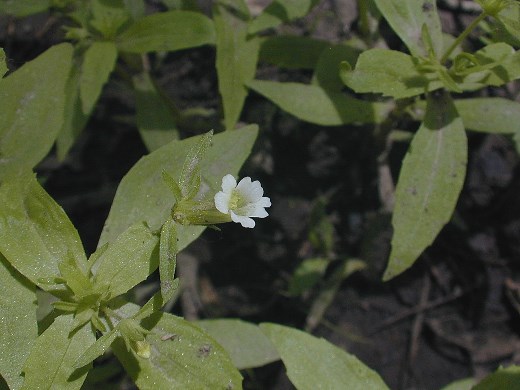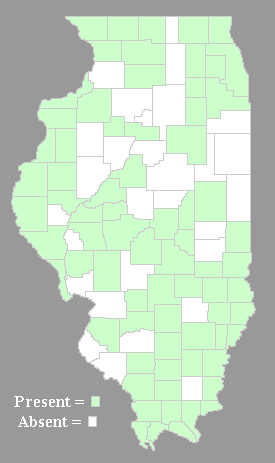Description: This annual plant is about 3-10" tall and more or less erect. It form short side branches along the upper half of the central stem, and sometimes branches along its lower half as well. The stems are light green and pubescent. The middle to upper opposite leaves are lanceolate, oblanceolate, or ovate; they are up to 1¾" long and ½" across. In contrast, the lowermost opposite leaves are linear-oblong; they are about the same length as the other leaves, but more narrow. Both kinds of leaves are light to medium green, hairless, sessile, and dentate or smooth along the margins.

Individual flowers
develop from the axils of the upper leaves on pedicels up to 1" long.
Each flower has a tubular corolla about 1/3" long and a short tubular
calyx with 5 teeth. The front of the corolla is mostly white, while its
lower exterior is pale yellow or green with fine veins. The outer rim
of the corolla has several spreading lobes that are short and rounded.
Inside the corolla, there are 2 fertile stamens, 2 abortive stamens,
and a slender style. The exterior of the calyx is green and pubescent;
its teeth are slender and often recurved. At the base of each flower,
there are a pair of small leafy bracts that are lanceolate or
lanceolate-linear in shape. The blooming period can occur from late
spring into the fall. While this is a long time period, individual
plants usually bloom for only 1-2 months before they die down. Each
flower is replaced by a small seed capsule that is ovoid and pointed at
its apex; it contains many small seeds. The root system consists of a
slender branching taproot. This plant spreads by reseeding itself, and
it readily forms colonies at favorable sites.

Cultivation:
The preference is full sun to light shade, wet conditions, and exposed
muddy soil. Shallow water is tolerated if it is temporary. This
opportunistic plant develops very quickly from seed when the ground is
wet. It also dies down quickly after its seeds become mature.
Range & Habitat:
Clammy Hedge Hyssop is occasional to locally common throughout
Illinois, where it is native. Habitats include floodplain forests,
muddy depressions in
upland woodlands, gravelly seeps, degraded soggy meadows, mud puddles
along woodland paths, and poorly drained fields. This little plant
likes to colonize disturbed areas.
Faunal Associations:
The nectar and pollen of the flowers attract Halictid bees and other
small bees. The tiny seeds probably cling to the feet of animals and
the shoes of humans as they pass through the muddy areas where this
plant grows. Later, these seeds are released into new areas where they
may germinate.
Photographic Location:
A muddy depression in Busey Woods, Urbana, Illinois.
Comments:
This is another small annual in the Figwort family. Unless a large
colony happens to be in bloom, it is easy to overlook. Clammy Hedge
Hyssop can be distinguished from a similar species, Gratiola
virginiana (Round-Fruited Hedge Hyssop), by its pubescent
stems and ovoid seed capsules. In contrast, the latter species has
succulent glabrous stems and globoid seed capsules. Another small
annual in the Figwort family that likes wetland areas, Lindernia
dubia (False Pimpernel), lacks pairs of leafy bracts
underneath its flowers. Its leaves are usually wider in shape and more
shiny than those of Clammy Hedge Hyssop. In spite of the common name,
Clammy Hedge Hyssop is not normally found around hedges. This probably
refers to the habitat preferences of a European species in this genus.